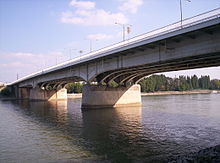Árpád Bridge
Coordinates: 47 ° 32 ′ 16 ″ N , 19 ° 3 ′ 12 ″ E
| Árpád Bridge | ||
|---|---|---|
| Official name | Árpád híd | |
| use | Road traffic , pedestrians, trams | |
| Crossing of | Danube | |
| place | Budapest in Hungary | |
| construction |
Girder bridge haunched solid wall girders |
|
| overall length | 928 m | |
| width | 26 m | |
| Longest span | 103 m | |
| start of building | 1939 | |
| completion | 1950 | |
| planner | János Kossalka | |
| location | ||
|
|
||
| Above sea level | 98 m | |
The Árpád Bridge ( Hungarian Árpád híd ) is one of the nine road bridges over the Danube in Budapest . With a length of 928 meters, it connects the Pest and Buda districts for tram and tram traffic. It touches the northern extension of Margaret Island and the southern tip of the Óbuda Island.
In 1950 the structure was inaugurated as the Stalin Bridge . In the course of de-Stalinization in 1956 it was given its current name. In doing so, the city honored the Grand Prince Árpád , who is considered to be the leading figure after the Hungarian conquest and founder of the Árpáden dynasty.
history
As early as 1903, the Budapest city council had passed a memorandum on the construction of a bridge at this point. But it wasn't until 1929 that an architectural competition took place, from which the winning design was a girder bridge. Construction began ten years later, but work came to a standstill in 1943 due to the effects of the Second World War . Finally, the Danube crossing was finally completed in 1950. However, lack of money meant that it was not built in the estimated width. It was not until 1981 to 1984 that the bridge was subsequently widened from 13 to 26 meters.
Web links
- Historical photos of the Árpád Bridge ( Memento from September 27, 2011 in the Internet Archive )
- Aerial photos of the Árpád Bridge


